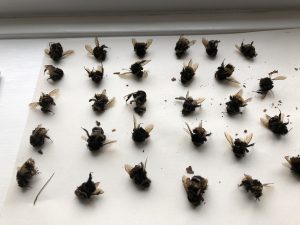Was it a Great tit that killed 29 Bombus terrestris queens?
Recently, while walking along a footpath through a small birch woodland, I saw and filmed a B. terrestris queen digging a hole into the peaty earth, something I have seen several times now and indicative of her being infected with nematode worm Sphaerularia bombi. A few feet further along I found one dead B. Terrestris queen with her abdomen contents empty. I suspect bird predation and decided to search the footpath area. In total, I found 29 dead B. terrestris queens along 45 yards of this path, and although not looking in particular for pollen on their rear legs I did not see any visible signs as I was laying them out for the photo, implying all of them may not have established a nest.
The Bumblebee Conservation Trusts states that “Birds often eat adult bees that are outside of the nest. In particular, robins and great tits have been found to catch bumblebees, rub them on branches to remove the stings, and then to peck out the insides!” I found no bumblebee nests in the area. I suspect, a predatory bird, probably a Great tit or even a robin, themselves getting into breeding condition, see bumblebee queens as a tasty morsel and an opportunistic meal. That’s nature!
Sting removed
Their stings would have been expertly dealt with and the whole insides of their abdomen had been completely removed. It’s probable that these queens were on or very near the ground when a bird caught them, held them with its claw and pecked at their abdomens, removed or damaged the sting and then consumed the nutritious juicy insides along with any nectar inside her ‘honey stomach’. A few had been attacked by pecking at the thorax and not the abdomen, in which case the bird may have pinned down the bee to the ground and dealt with it that way.

Was it a Great tit that killed all the bumblebee queens?
I saw no evidence of any spring wildflowers in the woodland, nor have I ever noticed any in the past. As they were all B. terrestris queens there are two possibilities. One is that these bees display nest site seeking behaviour by flying above the ground, dropping then walking to investigate potential nest sites. Hence a predatory bird could more easily attack them whilst they were on the ground rather than flying above it and literally pounced on them. Secondly, any queen B. terrestris bumblebees infected with nematodes and digging a hole into the earth, would leave them vulnerable to attack. Being on or very near the ground would leave very little room for bees to take any evasive action from a predator attack from above. Click on the photo for a clearer view.
I have watched both Great tits and Robins perch on the roof and on a branch next to an active bumblebee nest in a bird box containing tree bumblebees, follow the bee’s movements moving their heads to keep an eye on them as they approached the entrance and try to snap at them, though many were unsuccessful.
See BBC film of Great tit catching a bumblebee outside its nest
For more information, photos, films, etc., of bumblebee pests and predators
For more information about Bumblebees: Bumblebee Conservation Trust
Interested in Citizen Science and pollinators? : The Buzz Club

Though it may not have survived the sting removal process, signs of pollen on the hind legs is one way of finding out that queens have already established a nest.
Thank you for that Alan. Cheers George
Nice article. I have just seen the same Bombus carnage in very similar woodland in Epping Forest. The bees could almost have numbered 29 although we didn’t count them. Significantly they were all around a single tree BUT weren’t under it. This made me think the bird ate them on the ground. We have also seen a green woodpecker in the same location so wondered if that might be causing the Bombusocide. I guess the bird might also have dropped the bees as it flew out of the tree.
Hi William, I suspect the bees I found had been eaten on the ground caught as they ‘nest site seek’ along, on and just above the ground. All within a very shore space. Not sure about green woodpeckers, I do know it was not one of them where I found them. I have never heard or seen one at all in 12 years here. Cheers George